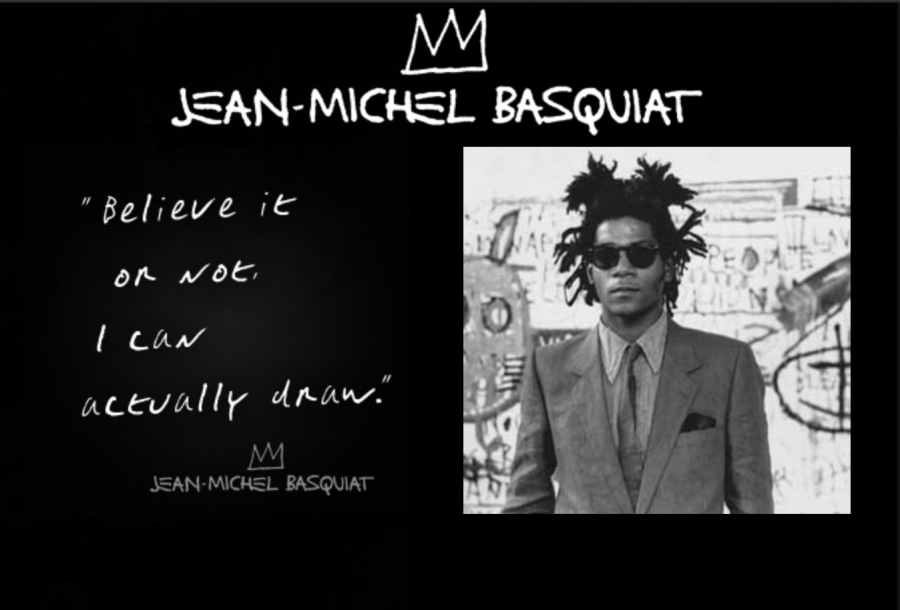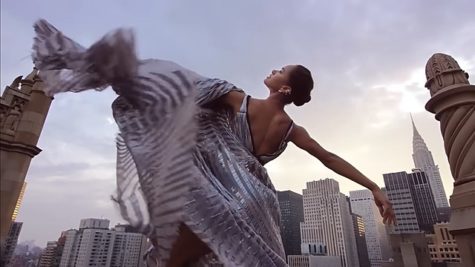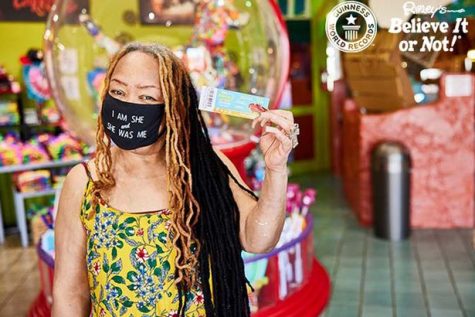From NYC Graffiti Street Artist to The Resurgence of Jean-Michel Basquiat
Honoring Classic Black History Artist
For those attending Mr. Johnson’s Digital Design course here at Parks, the students have been spending the past month learning about the seven elements of art through the works of African American artists. Anyone who knows me, understands all too well that I’m a certified junkie when it comes to museums. I can (and I have) spent hours meandering throughout museums any and every chance I can get, with the hopes of catching a glimpse of my favorite pieces. My love for museums first began while touring Steve Wynn’s private collection in Las Vegas when I was about four years old. It didn’t escape me that I was inches away from countless Picasso’s, Monets, Manets, and what eventually became my favorite, Andy Warhol. I even loved there was a Warhol hanging right in our hotel room so I could wake up, and go to sleep to it each night.
Then a few years later, I discovered the super elusive, Banksy, while watching the documentary “Exit Through The Gift Shop.” “What a clever name I remember thinking,” but what excited me more was there was an artist out there, who was willing to run, not walk to the edge, and see exactly what he could get away with while creating masterpieces where you’d least expect them. That, combined with a beautiful sentimental, yet extremely powerful element of vandalism revolving around political issues couldn’t be ignored. Even those not into art could recognize a Banksy and admire, if not support his work.
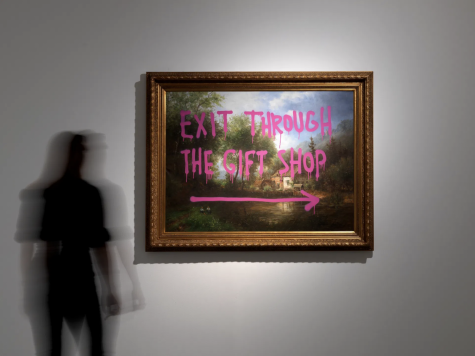
So when Mr. Johnson asked us to reflect on a famous painting, it didn’t take me long to pick the portrait “Grillo” by Jean-Michel Basquiat. In my mind, I always thought if Andy Warhol and Banksy were to have a love child, it would most likely turn out to be Basquiat. Art is objective. And while I love all types, there is something about Basquiat’s neo-expressionism graffiti street style art that I find mesmerizing. As I would look closer and closer, I always found myself thinking the same thing, “What could be going on in this man’s head?” Often, I wouldn’t even come close to trying to figure out it. Sometimes I wonder if his artwork holds the key to the reason he’s a member of the “27 Club.”
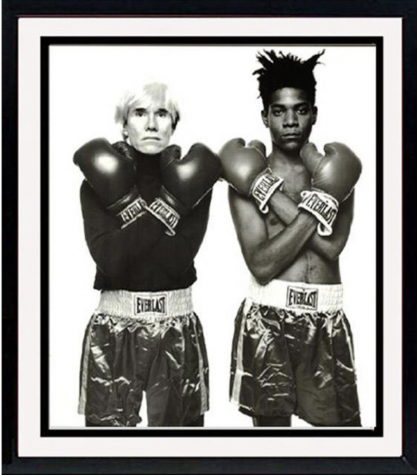
The Life of Jean-Michel Basquiat
American artist, Jean-Michel Basquiat, who was born and died in New York City will forever be known as getting his start in the art world as part of the “SAMO” graffiti duo in the Lower East Side of Manhattan. His form and style for the most part were constantly changing to reflect the political times, and neighborhood cultures which were unavoidable. It was a time where music reigned supreme thanks to Ian Schrager and Peter Gaiten who were the “honorary mayors” of the Manhattan nightlife. You may have heard of them as the partners who transformed an abandoned cathedral into New York City’s premier club, The Limelight, which hosted a hotbed of who’s who celebrities like his longtime girlfriend Madonna, and Warhol, to the notorious club kids who promoted the scene and one of the greatest Pearl Jam concerts to go down in history.
Basquiat embraced an up-and-coming culture which can be seen within his works, depicting chaos due to the melting pot of street art meets rap, punk, dance, and hip-hop. Many of his creations are a marriage of “abstraction, figuration, history,” and particularly to identify his personal experiences he was exposed to growing up as a black man tackling racism with hopes of supporting social class struggles. As I mentioned, Basquiat joined the “27 Club” in 1988, by living fast and dying young, but over three decades later, his works have grown more popular than ever. After he died, a 1982 painting by Basquiat sold for $110.5 million becoming one of the most expensive paintings ever purchased, even setting a record high for an American artist at auction. That’s a far cry from CBGB’s when Basquiat sold his first painting, Cadillac Moon in 1981, to singer and punk rock royalty, Debbie Harry, frontwoman for the band Blondie, for $200. Suddenly, Basquiat went from being a glorified graffiti artist who used sides of buildings as his canvas, to the youngest to exhibit at the Whitney Biennial in New York.
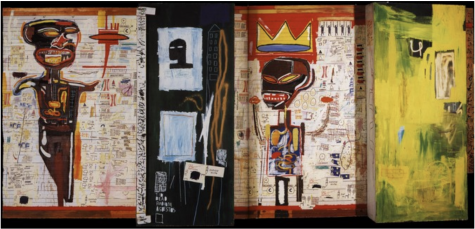
Grillo: Elements of Art
Despite Basquiat’s close relationship with Andy Warhol, Basquiat focused on portraying prominent black figures who he considered to be “Black Heros and Saints.” One of his signature trademarks was to place a crown or halo on his own self-portraits. This crown would have three peaks, to represent himself as a poet, musician, a great boxing champion. Basquiat paintings are typically covered with torn pieces of text he considered social commentary and codes of all kinds: words, letters, numerals, pictograms, logos, map symbols, diagrams, and more mixed modern tactics to call attention to political issues such as poverty and racism.
The other elements of art he incorporated in his Grillo piece were:
- Space: The red “sky” above Basquiat, shows not everything is always what it seems. In most photos, the sky is blue. It also is 2D and in this case is clearly just a backdrop.
- Line: Represented Basquiat’s homage to his graffiti street art roots that could be found on the sides of NYC subway cars. Showing horizontal, vertical, angles, curves, and shapes. It is the path that naturally moves through space, and your eye(s) follow.
- Texture: The texture in Grillos is beautiful. Each inch looks like torn pieces of notebook paper that could possibly be old journal entries of his.
- Form: Basquiat intentionally spent time carefully designing the inside of his anatomy with “off” colors that were not featured in other parts of the painting. This was to show we are all the same on the inside despite the racial tension Manhattan was facing during this time.
- Value: Basquiat does an exceptional job mixing lightness with darkness leaving the eye of the beholder to personally resonate with his work.
- Color: Vibrant highlighting the parts of his painting, Basquiat trusted that his choices would visibly stand out and have the light reflect the parts of his work he wanted to be noticed.
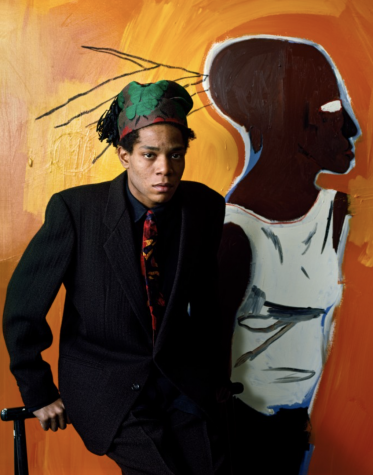
Researching Grillos made me want to know more about Basquiat. Especially, the close relationship between him and Warhol who were two avant-garde creative geniuses. I was surprised to learn they joined forces during the 1984 Olympics for a collaboration that depicted Warhol’s five-ring Olympic symbol in their original primary colors, while Basquiat added his unpredictable signature style and painted over them. Unfortunately, Basquiat’s drug use began to become much more than recreational especially after the death of Warhol. After many attempts to stay clean and multiple visits to rehabilitation clinics, Basquiat’s life was taken from us much too soon due to his dependency on cocaine and heroin.
Jean-Michel Basquiat’s death shook the art world and left the great artist, Keith Haring besides himself. So much that it inspired him to paint “A Pile of Crowns” in honor of Basquiat.”In the obituary Haring wrote for Vogue, he stated: “Jean-Michel truly created a lifetime of works in ten years. Greedily, we wonder what else he might have created, what masterpieces we have been cheated out of by his death, but the fact is that he has created enough work to intrigue generations to come. Only now will people begin to understand the magnitude of his contribution.”
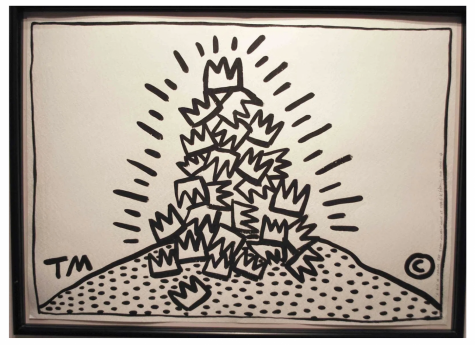
And it’s true. They have.
In 2017, Banksy created two works inspired by Basquiat on the walls of the Barbican. This came about before the opening of Basquiat’s exhibition “Boom for Real”. The first of the two works depict Basquiat’s painting Boy and Dog in a Johnnypump being searched by two police officers. Nina Koidl puts that the raised arms in the new work are a symbol of surrender, and is representative of the treatment of black artists (rather than of graffiti artists). The work was also accompanied by the statement “Portrait of Basquiat being welcomed by the Metropolitan police – an (unofficial) collaboration with the new Basquiat show“, a comment on the treatment of minorities by the police. The second work depicts a carousel with the carriages replaced with Crowns, a common motif throughout Basquiat’s work.
View this post on Instagram

Second-year Journalism student, Courtney Standley, was born into a world of rock and roll and mass media essentially making up the very fabric of her DNA....

